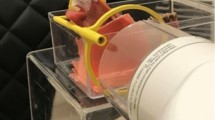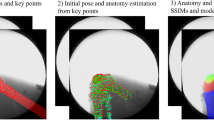Abstract
Purpose
Investigation of joint kinematics contributes to developing a better understanding of musculoskeletal conditions. However, the most commonly used optoelectronic motion analysis systems cannot determine the movements of underlying bone landmarks with high accuracy because of soft tissue artefacts. The aim of this paper was to present a computer-aided measurement system to track the underlying bone anatomy in a 3D global coordinate frame and describe hip joint kinematics of ten healthy volunteers during gait.
Methods
We have developed a measurement tool with an image-based computer-aided post-processing pipeline for automatic bone segmentation in ultrasound (US) images and a globally optimal 3D surface-to-surface registration method to quantify hip joint movements. The segmentation algorithm exploits US intensity profiles, including information about the integrated backscattering, acoustic shadows, and local phase features. A global optimization method is applied based on the traditional iterative closest point registration algorithm, which is robust to initialization. The International Society of Biomechanics recommended joint kinematics descriptor has been adapted to calculate the joint kinematics.
Results
The developed system prototype has been validated with a ball-joint femoral phantom and tested in vivo with 10 volunteers. The maximum Euclidean distance error of the automatic bone segmentation is less than 2 pixels (approximately 0.2 mm). The maximum absolute rotation angle error is less than \(4^{\circ }\).
Conclusion
This computer-aided tracking and motion analysis with ultrasound (CAT & MAUS) system shows the feasibility of describing hip joint kinematics for clinical investigation and diagnosis using an image-based solution.












Similar content being viewed by others
References
Department of Health (2006) The musculoskeletal services framework—a joint responsibility: doing it differently. Technical report
Powers CM (2003) The influence of altered lower-extremity kinematics on patellofemoral joint dysfunction: a theoretical perspective. J orthop Sports Phys Ther 33(11):639–646. doi:10.2519/jospt.2003.33.11.639
Monk AP (2011) The patellofemoral joint: form and function, Ph.D. thesis, University of Oxford
Peters A, Galna B, Sangeux M, Morris M, Baker R (2010) Quantification of soft tissue artifact in lower limb human motion analysis: a systematic review. Gait Posture 31(1):1–8
Foroughi P, Boctor E, Swartz MJ, Taylor RH, Fichtinger G (2007) Ultrasound bone segmentation using dynamic programming, in: IEEE ultrasonics symposium proceedings, pp 2523–2526. doi:10.1109/ULTSYM.2007.635. http://ieeexplore.ieee.org/lpdocs/epic03/wrapper.htm?arnumber=4410208
Hacihaliloglu I, Abugharbieh R, Hodgson AJ, Rohling RN (2009) Bone surface localization in ultrasound using image phase-based features. Ultrasound Med Biol 35(9):1475–1487. doi:10.1016/j.ultrasmedbio.2009.04.015
Hacihaliloglu I, Abugharbieh R, Hodgson AJ, Rohling RN, Guy P (2012) Automatic bone localization and fracture detection from volumetric ultrasound images using 3-D local phase features. Ultrasound Med Biol 38(1):128–144. doi:10.1016/j.ultrasmedbio.2011.10.009
Wein W, Karamalis A, Baumgartner A, Navab N (2015) Automatic bone detection and soft tissue aware ultrasound-CT registration for computer-aided orthopedic surgery. Int J Comput Assist Radiol Surg 10(6):971–979. doi:10.1007/s11548-015-1208-z. http://link.springer.com/10.1007/s11548-015-1208-z
Kowal J, Amstutz C, Langlotz F, Talib H, Ballester MG (2007) Automated bone contour detection in ultrasound B-mode images for minimally invasive registration in computer-assisted surgery—an in vitro evaluation. Int J Med Robot Comput Assist Surg 3(4):341–348. doi:10.1002/rcs.160
Zhang Z (1994) Iterative point matching for registration of free-form curves and surfaces. Int J Comput Vis 13(2):119–152. doi:10.1007/BF01427149. http://link.springer.com/10.1007/BF01427149
Fitzgibbon AW (2003) Robust registration of 2D and 3D point sets. Image Vis Comput 21(13–14):1145–1153. doi:10.1016/j.imavis.2003.09.004. http://linkinghub.elsevier.com/retrieve/pii/S0262885603001835
Yang J, Li H, Jia Y (2013) Go-ICP: solving 3D registration efficiently and globally optimally. 2013 IEEE international conference on computer vision 1457–1464 doi:10.1109/ICCV.2013.184. http://ieeexplore.ieee.org/lpdocs/epic03/wrapper.htm?arnumber=6751291
Barratt DC, Penney GP, Chan CSK, Slomczykowski M, Carter TJ, Edwards PJ, Hawkes DJ (2006) Self-calibrating 3D-ultrasound-based bone registration for minimally invasive orthopedic surgery. IEEE Trans Med Imaging 25(3):312–323. doi:10.1109/TMI.2005.862736
Monk AP, Chen M, Mellon S, Gibbons M, Beard DJ, Murray DW, Gill HS (2013) Comparison of in vivo coronal plane patella tracking following knee arthroplasty using the MAUS technique. Bone Jt J Orthop Proc Suppl 95(SUPP 26):10
Jia R, Mellon S, Monk P, Murray D, Noble JA (2015) Three dimensional freehand ultrasound reconstruction using hybrid interpolation. In: Medical image understanding and analysis, Lincoln, UK, pp 169–174
Felsberg M, Sommer G (2001) The monogenic signal. IEEE Trans Signal Process 49(12):3136–3144. doi:10.1109/78.969520. http://ieeexplore.ieee.org/lpdocs/epic03/wrapper.htm?arnumber=969520
Rajpoot K, Grau V, Noble JA (2009) Local-phase based 3d boundary detection using monogenic signal and its application to real-time 3-d echocardiography images. In: Proceedings—2009 IEEE international symposium on biomedical imaging: from nano to macro, ISBI 2009, pp. 783–786. doi:10.1109/ISBI.2009.5193166
Kovesi P (1999) Symmetry and asymmetry from local phase. In: Tenth Australian joint conference on artificial intelligence, pp 190–196
Jia R, Hansjee S, Monk AP, Murray DW, Mellon SJ, Noble JA (2016) Automatic bone segmentation in ultrasound images using local phase features and dynamic programming. In: 2016 IEEE 13th international symposium on biomedical imaging (ISBI)
Jia R, Monk AP, Murray DW, Mellon SJ, Noble JA (2015) Greater trochanter tracking in ultrasound imaging during gait. In: 2015 IEEE 12th international symposium on biomedical imaging (ISBI), IEEE, pp 260–263
Wu G, Siegler S, Allard P, Kirtley C, Leardini A, Rosenbaum D, Whittle M, D’Lima DD, Cristofolini L, Witte H, Schmid O, Stokes I (2002) ISB recommendation on definitions of joint coordinate system of various joints for the reporting of human joint motion–part I: ankle, hip, and spine. International Society of Biomechanics. doi:10.1016/S0021-9290(01)00222-6
Sawbones, Biomechanical test materials (2014) www.sawbones.com
MTR, Gait assessment (2014) http://www.massagetherapyreference.com/gait-assessment/
Ramakrishnan H, Kadaba M (1991) On the estimation of joint kinematics during gait. J Biomech 24(10):969–977
Billuart F, Devun GOSWL, Mitton D (2007) 3D kinematics of the glenohumeral joint during abduction motion: an ex vivo study. Surg Radiol Anat 29(4):291–295. doi:10.1007/s00276-007-0208-2
Acknowledgments
The authors would like to thank Orthopaedics Research UK for supporting this project (Grant code: HFR00390) and the China Scholarship Council for funding Rui Jia (CSC NO.201408-060234). We sincerely thank all the participants for volunteering in the experiments.
Author information
Authors and Affiliations
Corresponding author
Ethics declarations
Conflict of interest
The authors declare that they have no conflict of interest.
Ethical standard
All the in vivo experiments were in accordance with the ethical standards of the institutional and/or national research committee.
Rights and permissions
About this article
Cite this article
Jia, R., Mellon, S., Monk, P. et al. A computer-aided tracking and motion analysis with ultrasound (CAT & MAUS) system for the description of hip joint kinematics. Int J CARS 11, 1965–1977 (2016). https://doi.org/10.1007/s11548-016-1443-y
Received:
Accepted:
Published:
Issue Date:
DOI: https://doi.org/10.1007/s11548-016-1443-y




